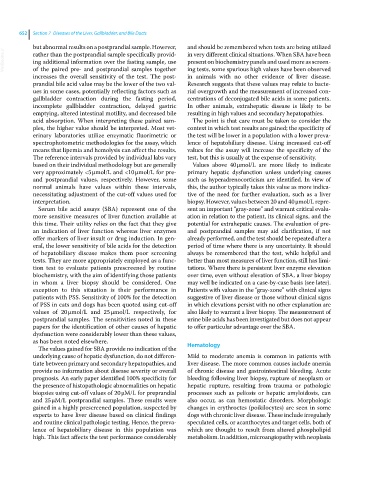Page 684 - Clinical Small Animal Internal Medicine
P. 684
652 Section 7 Diseases of the Liver, Gallbladder, and Bile Ducts
but abnormal results on a postprandial sample. However, and should be remembered when tests are being utilized
VetBooks.ir rather than the postprandial sample specifically provid- in very different clinical situations. When SBA have been
present on biochemistry panels and used more as screen-
ing additional information over the fasting sample, use
of the paired pre‐ and postprandial samples together
in animals with no other evidence of liver disease.
increases the overall sensitivity of the test. The post- ing tests, some spurious high values have been observed
prandial bile acid value may be the lower of the two val- Research suggests that these values may relate to bacte-
ues in some cases, potentially reflecting factors such as rial overgrowth and the measurement of increased con-
gallbladder contraction during the fasting period, centrations of deconjugated bile acids in some patients.
incomplete gallbladder contraction, delayed gastric In other animals, extrahepatic disease is likely to be
emptying, altered intestinal motility, and decreased bile resulting in high values and secondary hepatopathies.
acid absorption. When interpreting these paired sam- The point is that care must be taken to consider the
ples, the higher value should be interpreted. Most vet- context in which test results are gained; the specificity of
erinary laboratories utilize enzymatic fluorimetric or the test will be lower in a population with a lower preva-
spectrophotometric methodologies for the assay, which lence of hepatobiliary disease. Using increased cut‐off
means that lipemia and hemolysis can affect the results. values for the assay will increase the specificity of the
The reference intervals provided by individual labs vary test, but this is usually at the expense of sensitivity.
based on their individual methodology but are generally Values above 40 μmol/L are more likely to indicate
very approximately <5 μmol/L and <10 μmol/L for pre‐ primary hepatic dysfunction unless underlying causes
and postprandial values, respectively. However, some such as hyperadrenocorticism are identified. In view of
normal animals have values within these intervals, this, the author typically takes this value as more indica-
necessitating adjustment of the cut‐off values used for tive of the need for further evaluation, such as a liver
interpretation. biopsy. However, values between 20 and 40 μmol/L repre-
Serum bile acid assays (SBA) represent one of the sent an important “gray‐zone” and warrant critical evalu-
more sensitive measures of liver function available at ation in relation to the patient, its clinical signs, and the
this time. Their utility relies on the fact that they give potential for extrahepatic causes. The evaluation of pre‐
an indication of liver function whereas liver enzymes and postprandial samples may aid clarification, if not
offer markers of liver insult or drug induction. In gen- already performed, and the test should be repeated after a
eral, the lower sensitivity of bile acids for the detection period of time where there is any uncertainty. It should
of hepatobiliary disease makes them poor screening always be remembered that the test, while helpful and
tests. They are more appropriately employed as a func- better than most measures of liver function, still has limi-
tion test to evaluate patients prescreened by routine tations. Where there is persistent liver enzyme elevation
biochemistry, with the aim of identifying those patients over time, even without elevation of SBA, a liver biopsy
in whom a liver biopsy should be considered. One may well be indicated on a case‐by‐case basis (see later).
exception to this situation is their performance in Patients with values in the “gray‐zone” with clinical signs
patients with PSS. Sensitivity of 100% for the detection suggestive of liver disease or those without clinical signs
of PSS in cats and dogs has been quoted using cut‐off in which elevations persist with no other explanation are
values of 20 μmol/L and 25 μmol/L respectively, for also likely to warrant a liver biopsy. The measurement of
postprandial samples. The sensitivities noted in these urine bile acids has been investigated but does not appear
papers for the identification of other causes of hepatic to offer particular advantage over the SBA.
dysfunction were considerably lower than these values,
as has been noted elsewhere. Hematology
The values gained for SBA provide no indication of the
underlying cause of hepatic dysfunction, do not differen- Mild to moderate anemia is common in patients with
tiate between primary and secondary hepatopathies, and liver disease. The more common causes include anemia
provide no information about disease severity or overall of chronic disease and gastrointestinal bleeding. Acute
prognosis. An early paper identified 100% specificity for bleeding following liver biopsy, rupture of neoplasm or
the presence of histopathologic abnormalities on hepatic hepatic rupture, resulting from trauma or pathologic
biopsies using cut‐off values of 20 μM/L for preprandial processes such as peliosis or hepatic amyloidosis, can
and 25 μM/L postprandial samples. These results were also occur, as can hemostatic disorders. Morphologic
gained in a highly prescreened population, suspected by changes in erythroctes (poikilocytes) are seen in some
experts to have liver disease based on clinical findings dogs with chronic liver disease. These include irregularly
and routine clinical pathologic testing. Hence, the preva- speculated cells, or acanthocytes and target cells, both of
lence of hepatobiliary disease in this population was which are thought to result from altered phospholipid
high. This fact affects the test performance considerably metabolism. In addition, microangiopathy with neoplasia

